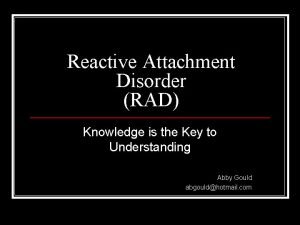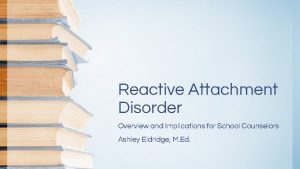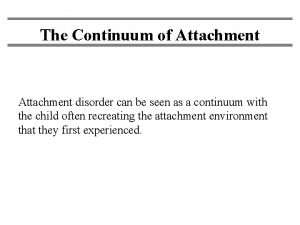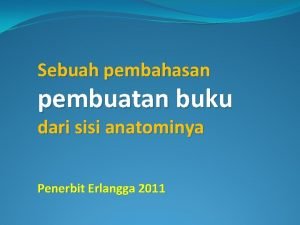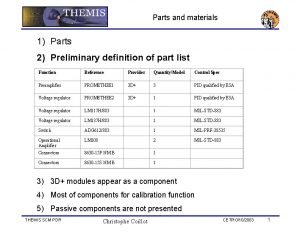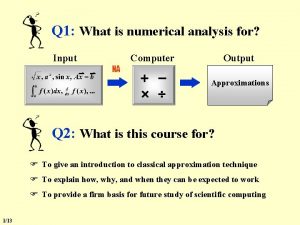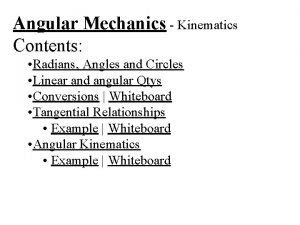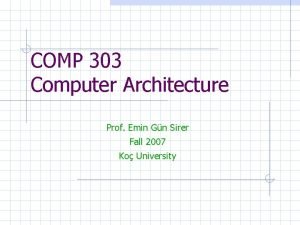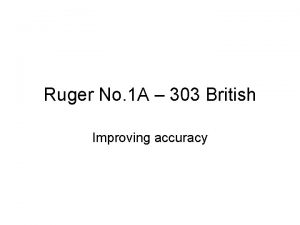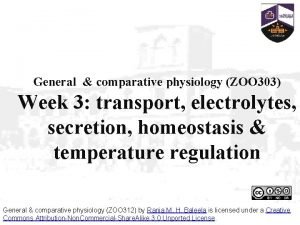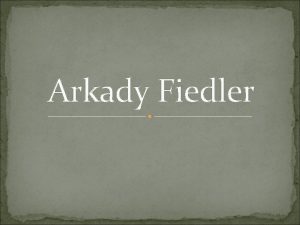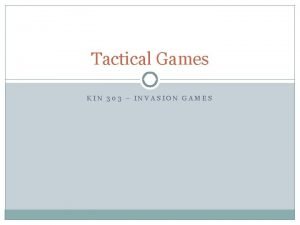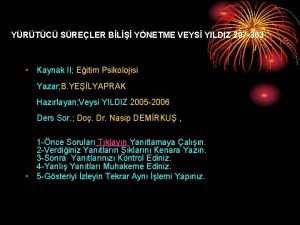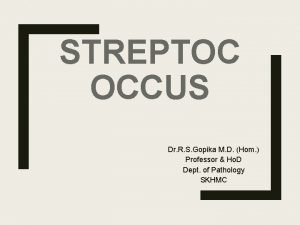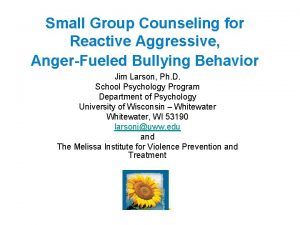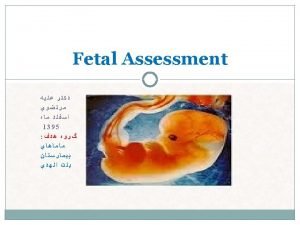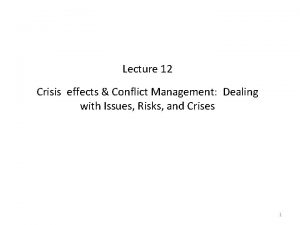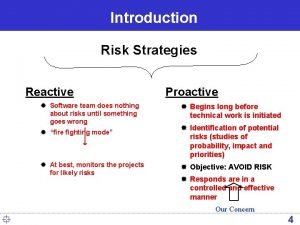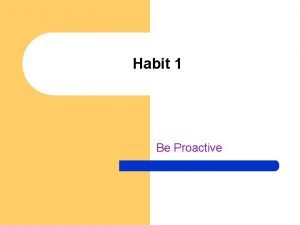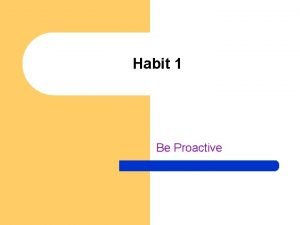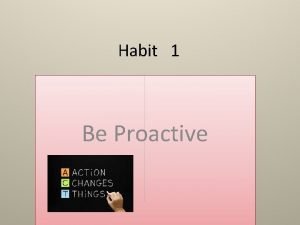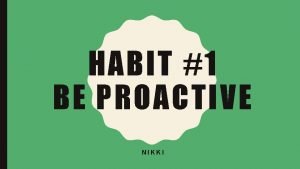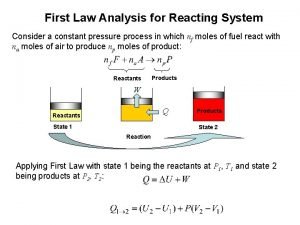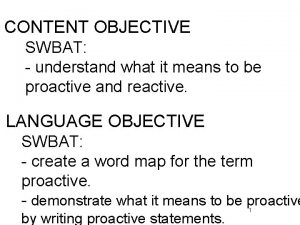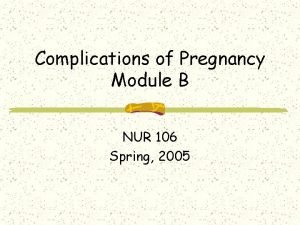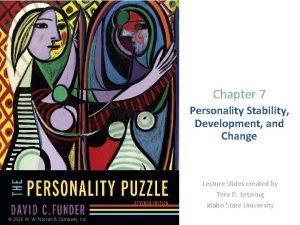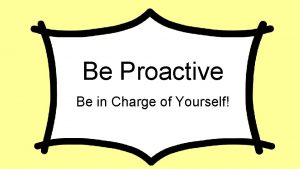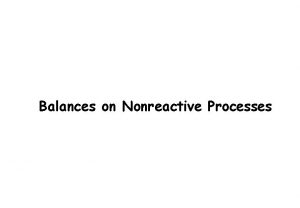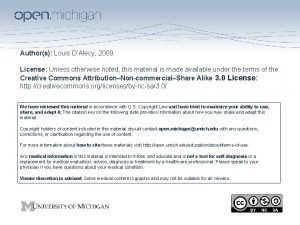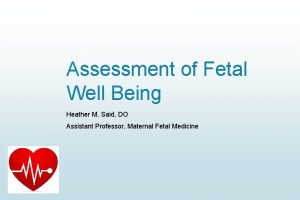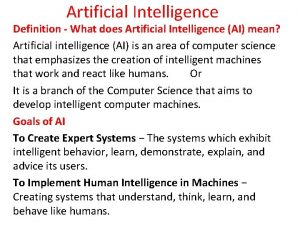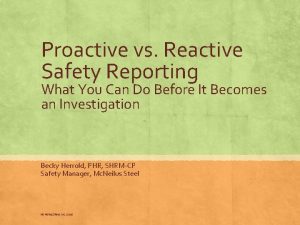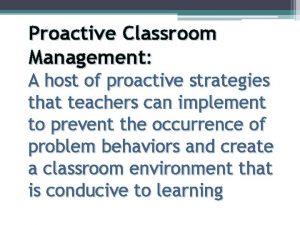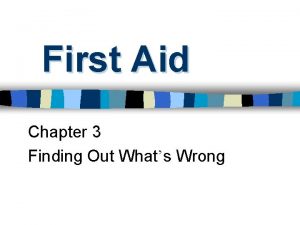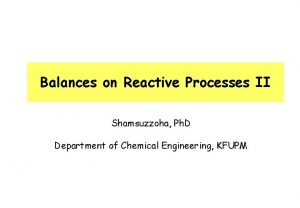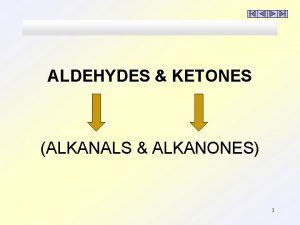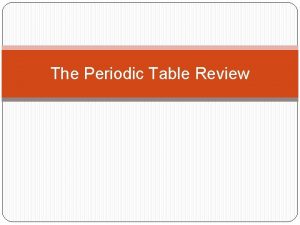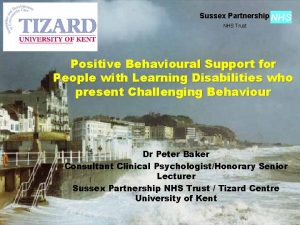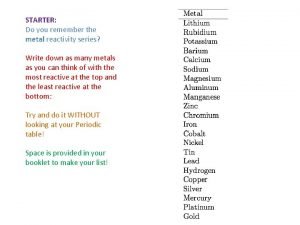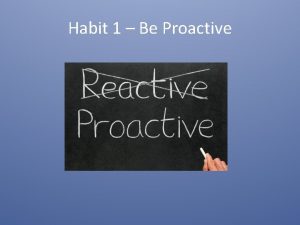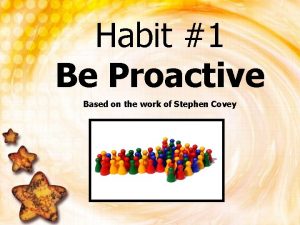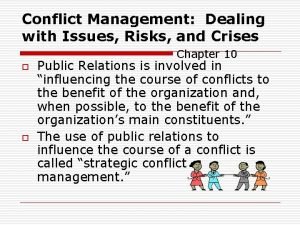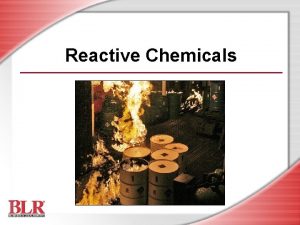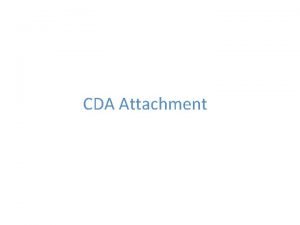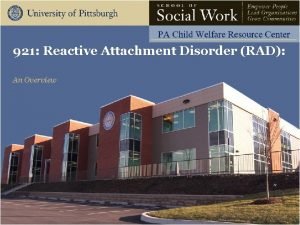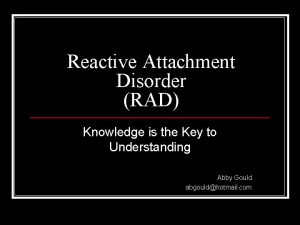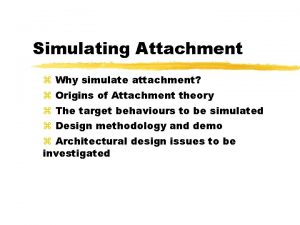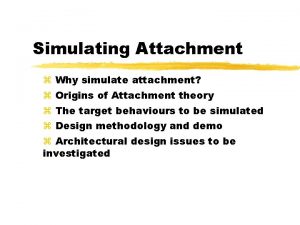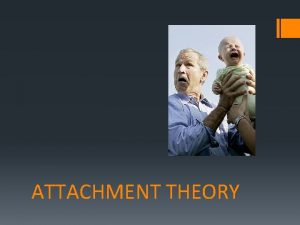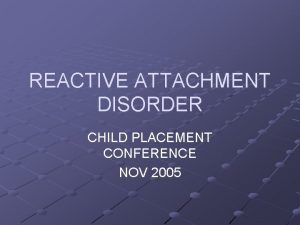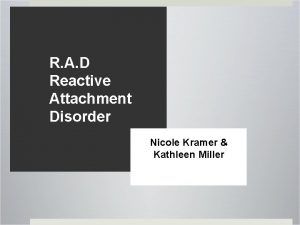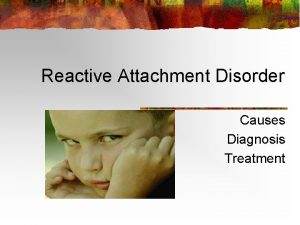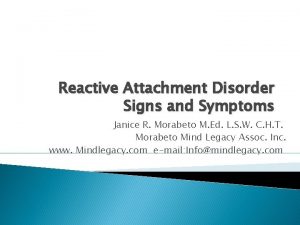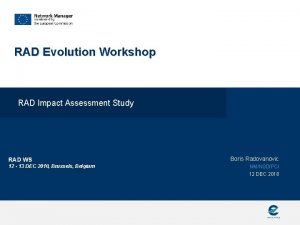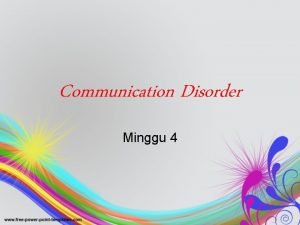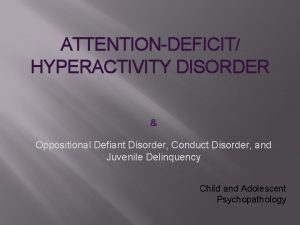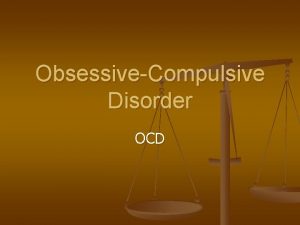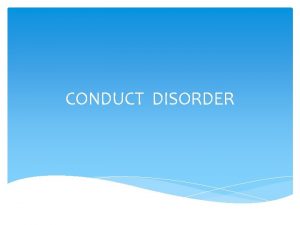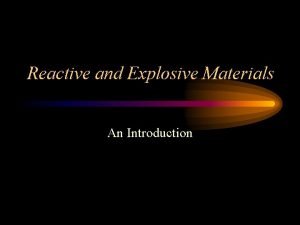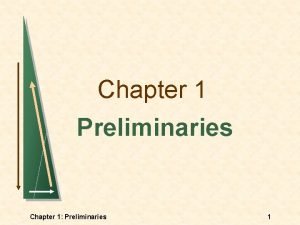303 Understanding Reactive Attachment Disorder RAD Introduction Preliminaries




















































































- Slides: 84

303: Understanding Reactive Attachment Disorder (RAD)

Introduction Ø Preliminaries Ø Outline of workshop Ø Tuning in The Pennsylvania Child Welfare Resource Center 303: Understanding Reactive Attachment Disorder (RAD) 2

What’s In It For Me? RAD Training Needs The Pennsylvania Child Welfare Resource Center 303: Understanding Reactive Attachment Disorder (RAD) 3

Learning Objectives • Define and describe Reactive Attachment Disorder (RAD) • Recognize how the diagnosis of RAD differs from the diagnoses of Disinhibited Social Engagement Disorder, Posttraumatic Stress Disorder, Sensory Processing Disorder, and Attention Deficit Hyperactivity Disorder • Identify the evaluation procedures and screening tools used to diagnosis RAD • Recognize current therapeutic techniques for RAD • Identify effective case management, parenting techniques and resources The Pennsylvania Child Welfare Resource Center 303: Understanding Reactive Attachment Disorder (RAD) 4

Competencies • 303. 3 The child welfare professional knows common emotional disorders of children and the behavior indicators and dynamics of these disorders, and can refer the child to the proper professional for further assessment and/or treatment The Pennsylvania Child Welfare Resource Center 303: Understanding Reactive Attachment Disorder (RAD) 5

Agenda I. III. IV. V. VII. Introduction Definition and symptoms of RAD Related Disorders and Differential Diagnosis Case Management Interventions Parenting Techniques Summary and closing The Pennsylvania Child Welfare Resource Center 303: Understanding Reactive Attachment Disorder (RAD) 6

Poll Think about your response to separating from the person(s) you are MOST attached to for 6 months. What would you want? A. To feel secure, I would not need any contact. B. To feel secure, I would want monthly contact. C. To feel secure, I would want weekly contact. D. To feel secure, I would want daily contact. E. To feel secure, I would tell them don’t go! The Pennsylvania Child Welfare Resource Center 303: Understanding Reactive Attachment Disorder (RAD) 7

Section II: Definition and Symptoms Ø DSM-5 definition of RAD Ø RAD symptoms Ø Attachment The Pennsylvania Child Welfare Resource Center 303: Understanding Reactive Attachment Disorder (RAD) 8

Definition and Symptoms of RAD I • A consistent pattern of inhibited, emotionally withdrawn behavior toward adult caregivers, evident before age 5, and manifested by both of the following: – Rarely or minimally seeks comfort when distressed – Rarely or minimally responds to comfort offered when distressed • A persistent social and emotional disturbance characterized by at least 2 of the following: – Minimal social and emotional responsiveness to others – Limited positive affect – Episodes of unexplained irritability, sadness, or fearfulness which are evident during nonthreatening interactions with adult caregivers (American Psychiatric Association, 2013) The Pennsylvania Child Welfare Resource Center 303: Understanding Reactive Attachment Disorder (RAD) 9

Definition and Symptoms of RAD II • Child has experienced a pattern of extremes of insufficient care (pathogenic care) as evidenced by at least one of the following: – Persistent disregard of the child’s basic emotional needs for comfort, stimulation, and affection (i. e. , neglect) – Persistent disregard of the child’s basic physical needs. – Repeated changes of primary caregiver that prevent formation of stable attachments (e. g. , frequent changes in foster care) – Rearing in unusual settings such as institutions with high child/caregiver ratios that limit opportunities to form selective attachments • Not due to Autism Spectrum Disorder (American Psychiatric Association, 2013) The Pennsylvania Child Welfare Resource Center 303: Understanding Reactive Attachment Disorder (RAD) 10

Beliefs: About Self and the World • • People are untrustworthy and inconsistent World is chaotic, unpredictable and unsafe Nothing I say or do has an impact, not on others, myself or situations My needs will only be met through my own efforts: I have to do it all myself The Pennsylvania Child Welfare Resource Center • • I am worthless, unlovable and bad I am unsafe and weak Caretakers are unresponsive, unreliable and dangerous The world is hostile and dangerous (Cross, 2003) 303: Understanding Reactive Attachment Disorder (RAD) 11

Child of Rage: A Story of Abuse Documentary: Video Clips of Parts I & II: http: //www. youtube. com/watch? v=ME 2 wm. Fun. Cj. U&fea ture=youtube_gdata_player (Source: HBO in association with The National Committee for Prevention of Child Abuse, 1990) The Pennsylvania Child Welfare Resource Center 303: Understanding Reactive Attachment Disorder (RAD) 12

Small Group Discussion Questions: What do you think the girl’s feelings and beliefs are about herself? About her family? About her sibling? The Pennsylvania Child Welfare Resource Center 303: Understanding Reactive Attachment Disorder (RAD) 13

Newborn Video Activity As you watch this video, identify components of attachment making sure to include: 1. 2. 3. 4. 5. Eye contact Touch Feeding Movement Smiles The Pennsylvania Child Welfare Resource Center 303: Understanding Reactive Attachment Disorder (RAD) 14

Brain Development (Neurobiology) and Attachment • Frontal Lobes – Manages manage impulse control, social reasoning, organization and planning • Amygdala – Assesses threats and danger in the environment and results in fight, flight or freeze responses (Perry & Szalavitz, 2006, ) The Pennsylvania Child Welfare Resource Center 303: Understanding Reactive Attachment Disorder (RAD) 15

Normal Cycle of Attachment • infant feels need (hunger, pain, attention) • infant is aroused and expresses need (cry) • response/gratification (need is promptly met in nurturing way) • relief/relaxation (infant feels relief and relaxes, develops TRUST) The Pennsylvania Child Welfare Resource Center 303: Understanding Reactive Attachment Disorder (RAD) 16

Normal Cycle of Attachment Need Relief Relaxation Arousal Expression Response Gratification The Pennsylvania Child Welfare Resource Center 303: Understanding Reactive Attachment Disorder (RAD) 17

Disrupted Cycle of Attachment Need Discomfort/Fear/ Anxiety -> Lack of Trust in Others & Lack of Empathy Arousal Expression -> Apathy No Response -> Anger The Pennsylvania Child Welfare Resource Center 303: Understanding Reactive Attachment Disorder (RAD) 18

Attachment Disruptions Signs & Symptoms: Behaviors INFANCY SCHOOL AGE ADOLESCENCE Lack of eye contact Excessive tantrums Tantrums continue Possible drug/alcohol abuse Inability to sooth Difficulty forming close peer relationships Does not express needs Possible low development and weight gain TODDLER Difficulty selfregulating Affectionate on their own terms Possible encopresis/ Frozen Enuresis watchfulness Possible lying, hoarding, stealing, destruction of property The Pennsylvania Child Welfare Resource Center Difficulty forming intimate relationships 303: Understanding Reactive Attachment Disorder (RAD) 19

Attachment Disorder Cycle • • infant feels need (hunger, pain, attention) infant is aroused and expresses need (cry) there is no response, or response is angry/punitive there is not relief/relaxation (infant develops anger/rage and learns not to depend on caregivers for need satisfaction) The Pennsylvania Child Welfare Resource Center 303: Understanding Reactive Attachment Disorder (RAD) 20

Attachment Activity In your table group: q Review the assigned Attachment Activity card q Read the materials referenced in the Child and Adolescent Development Resource Manual q Record findings on your flip chart paper q Identify a reporter q Be prepared to report findings to the large group The Pennsylvania Child Welfare Resource Center 303: Understanding Reactive Attachment Disorder (RAD) 21

Continuum of Attachment SECURE ANXIOUS Comfortable with Resists or closeness and trust ambivalent about closeness Felt security or trust DISORGANIZED NONATTACHED Unable to trust or be close Unable to form emotional connections May lack remorse Lacks conscience Vulnerability acceptable Positive working model Individuality, togetherness balanced Moderately controlling and insecure Negative working model Aggressive and punitive control Negative working model (severe) Pseudoindependent Predatory behaviors Negative working model (severe) Extreme narcissism Rejecting or clingy (From: Attachment, Trauma, and Healing, p. 94) The Pennsylvania Child Welfare Resource Center 303: Understanding Reactive Attachment Disorder (RAD) 22

Risk Factors for Pathogenic Care abuse neglect maternal postpartum depression maternal mental illness substance abuse of parent inexperienced parent inconsistent caregiving many different caregivers The Pennsylvania Child Welfare Resource Center 303: Understanding Reactive Attachment Disorder (RAD) 23

Section III: Related Disorders and Differential Diagnosis Ø Symptom comparison Ø Diagnosis and treatment The Pennsylvania Child Welfare Resource Center 303: Understanding Reactive Attachment Disorder (RAD) 24

Disinhibited Social Engagement Disorder (DSED) • Attachment present/not • Reduced or absent reticence to approach and interact with unfamiliar adults • Overly familiar behavior (verbal or physical violation of culturally sanctioned social boundaries) • Diminished or absent checking back with adult caregiver after venturing away • Willingness to go off with an unfamiliar adult with minimal or no hesitation (American Psychiatric Association, 2013) The Pennsylvania Child Welfare Resource Center 303: Understanding Reactive Attachment Disorder (RAD) 25

Posttraumatic Stress Disorder (PTSD) • Symptoms of avoidance and emotional numbing • Symptoms of intrusive memories – Flashbacks – Nightmares • Symptoms of altered cognitions and mood (American Psychiatric Association, 2013) The Pennsylvania Child Welfare Resource Center 303: Understanding Reactive Attachment Disorder (RAD) 26

Sensory Processing Disorder (SPD) • Difficulty processing sensory input – Sight – Sound – Taste – Smell – Touch – Proprioceptive (body positioning in space) – Vestibular (balance) • Hyper (over) or hypo (under) reactive in one or more senses (Sensory Processing Disorder Foundation, 2013) The Pennsylvania Child Welfare Resource Center 303: Understanding Reactive Attachment Disorder (RAD) 27

Attention Deficit Hyperactivity Disorder (ADHD) • Primary feature is a persistent pattern of inattention and/or hyperactivity-impulsivity that interferes with functioning or development • Present before age 12 and manifests in two or more settings • Three subtypes within the disorder – Predominantly Inattentive – Predominantly Hyperactive/Impulsive – Combined (American Psychiatric Association, 2013) The Pennsylvania Child Welfare Resource Center 303: Understanding Reactive Attachment Disorder (RAD) 28

Evaluation Process for RAD • Direct observation of the baby's or child's interaction with his or her parents or caregivers • Details about the baby's or child's pattern of behavior over time; examples of the baby's or child's behavior in a variety of situations • Information about how the baby or child interacts with parents or caregivers as well as others, including other family members, peers and teachers • Questions about the baby's or child's home and living situation since birth • An evaluation of parenting and caregiving styles and abilities (Mayo Clinic, 2013) The Pennsylvania Child Welfare Resource Center 303: Understanding Reactive Attachment Disorder (RAD) 29

Attachment Behavior Q-SET Child readily shares with mother or lets her hold things if she asks When child returns to mother after playing, he is sometimes fussy for no clear reason When he is upset or injured, child will accept comforting from adults other than mother Child is careful and gentle with toys and pets Child is more interested in people than things When child is near mother and sees something he wants to play with, he fusses or tries to drag mother over to it The Pennsylvania Child Welfare Resource Center 303: Understanding Reactive Attachment Disorder (RAD) 30

RAD-Q SAMPLE My child acts cute or charms others to get them to do what s/he wants My child has trouble making eye contact when adults talks to him/her My child pushes me away or becomes stiff when I try to hug him/her, unless s/he wants something from me My child has a tremendous need to have control over everything, becoming upset if things don’t go his/her way The Pennsylvania Child Welfare Resource Center 303: Understanding Reactive Attachment Disorder (RAD) 31

Section IV: Case Management Ø Principles of Case Management Ø Case Studies Ø Daily Review The Pennsylvania Child Welfare Resource Center 303: Understanding Reactive Attachment Disorder (RAD) 32

Case Management Activity • In small groups, discuss your assigned topic area: 1. Purpose and value of pre-placement visits (child with foster family and worker with family of origin); 2. Purpose and value of post-placement visits (worker with child, family of origin and foster family); 3. Purpose and value of contacts with family of origin during placement (both child and worker); or 4. Role of the foster family when child leaves their home. • Write/discuss your assigned concept and how it might apply to a child with RAD • Prepare to share The Pennsylvania Child Welfare Resource Center 303: Understanding Reactive Attachment Disorder (RAD) 33

Pre-Placement Visits • Diminish fears and worries of the unknown. • Can be used to transfer attachments. • Initiate grieving process. • Empower new caregivers. • Encourage making commitments for future The Pennsylvania Child Welfare Resource Center 303: Understanding Reactive Attachment Disorder (RAD) 34

Post-Placement Contacts • Prevent denial/avoidance. • Resurface emotions about separation at manageable levels. • Provide opportunities for support of feelings. • Decrease magical thinking. • Decrease loyalty issues. • Continue transference of attachment/empowerment of new caretakers. The Pennsylvania Child Welfare Resource Center 303: Understanding Reactive Attachment Disorder (RAD) 35

Contact with Family of Origin • Assess: – Parent-child attachment – Parenting skills – Nature of family interactions & – Tasks necessary for reunification; • Facilitate grieving process; • Decrease loyalty conflicts; • Strengthen attachments and bonds; • Facilitate changes in family relationships; and • Facilitate reunification. The Pennsylvania Child Welfare Resource Center 303: Understanding Reactive Attachment Disorder (RAD) 36

Resource Family Role • • Acknowledge mixed feelings of child; Allow expression of feelings; Let child know they care; Provide clear explanations for the move; • Maintain contact; and • Accept regression. The Pennsylvania Child Welfare Resource Center 303: Understanding Reactive Attachment Disorder (RAD) 37

Case Studies Activity • Madison (age 16) and Meghan (newborn) • Tiana (age 8) • Tasha (age 4 ½) • Carrie (age 3) The Pennsylvania Child Welfare Resource Center 303: Understanding Reactive Attachment Disorder (RAD) 38

Day 1: Review • • • Definition of RAD Description of RAD Attachment cycle Differential diagnosis Case management principles The Pennsylvania Child Welfare Resource Center 303: Understanding Reactive Attachment Disorder (RAD) 39

Day 2: Overview • Interventions – Medication – Therapy – Parenting Techniques • Resources • Closure The Pennsylvania Child Welfare Resource Center 303: Understanding Reactive Attachment Disorder (RAD) 40

Questions? The Pennsylvania Child Welfare Resource Center 303: Understanding Reactive Attachment Disorder (RAD) 41

303: Understanding Reactive Attachment Disorder (RAD) Day 2

Day 2 Agenda • Interventions – Types of therapy • Parenting techniques • Resources • Summary and closing The Pennsylvania Child Welfare Resource Center 303: Understanding Reactive Attachment Disorder (RAD) 43

Interventions Ø Attachment therapy ØCharacteristics of an attachment therapist Ø Theraplay Ø Eye Movement Desensitization Reprocessing Ø Neurofeedback Ø Occupational therapy for sensory integration The Pennsylvania Child Welfare Resource Center 303: Understanding Reactive Attachment Disorder (RAD) 44

Therapy Q: What factor does all therapy depend upon for success? A: TRUSTING RELATIONSHIP AND RECIPROCITY BETWEEN THERAPIST AND CHILD Q: What characteristics of children with RAD would interfere with success in traditional therapy? A: LACK OF TRUST AND DEVELOPMENT OF RELATIONSHIPS, MANIPULATIVE The Pennsylvania Child Welfare Resource Center 303: Understanding Reactive Attachment Disorder (RAD) 45

Principles of Attachment Therapy • • Child must be motivated to change Utilizes a systems model Includes the caregiver(s) in the treatment Deals with early trauma through conscious or unconscious memory • Corrects irrational thinking (beliefs about self and the world) • Facilitates attachment to caregivers through nurturance The Pennsylvania Child Welfare Resource Center 303: Understanding Reactive Attachment Disorder (RAD) 46

Therapist Provides ØStructure ØAttunement ØEmpathy ØPositive affect ØSupport ØReciprocity The Pennsylvania Child Welfare Resource Center 303: Understanding Reactive Attachment Disorder (RAD) 47

Attachment Therapy • Focus is on building attachment between child and parents through nurturing touch, structure, attunement, empathy, support, positive affect, and reciprocity • Sometimes holding is used to reduce “alarm” reaction • Holding provides deep pressure sensation, which the brain interprets as safe and calming. • In holding, the child is better able to process information and use their cortex for new learning • Promotes self-regulation • Provides structure and sets limits on the child with acting out behaviors in a safe, nurturing environment • Facilitates corrective experiences when others are in control Child of Rage, Part III The Pennsylvania Child Welfare Resource Center 303: Understanding Reactive Attachment Disorder (RAD) 48

Attachment Therapy Pros Cons • Addresses alarm reaction • Helps with selfregulation of alertness and activity level • Sets limits in safe environment • Reduces need for control on the part of the child • News reports of child's death in "holding therapy" impact parents’ willingness to try this technique • Some feel this can retraumatize the child, especially if sexually abused • Ongoing debate over parent vs. therapist holding The Pennsylvania Child Welfare Resource Center 303: Understanding Reactive Attachment Disorder (RAD) 49

Theraplay • Addresses four areas: structure, engagement, nurturing touch, challenge • Started by Ann Jernberg in her role as director of psychological services for Head Start • Theraplay was registered as a service mark in 1976; this means you have to be trained to call yourself a Theraplay therapist. The Pennsylvania Child Welfare Resource Center 303: Understanding Reactive Attachment Disorder (RAD) 50

Theraplay Video View the video Theraplay and identify the Theraplay principles of structure, engagement, nurturing, and challenge of identified in the video. http: //www. theraplay. org/ The Pennsylvania Child Welfare Resource Center 303: Understanding Reactive Attachment Disorder (RAD) 51

Theraplay • Therapist takes charge, planning and structuring sessions to meet child's needs, rather than waiting for the child to lead way • Treatment focuses on the relationship, not the inner psyche • Nurturing touch is an integral part of the interaction The Pennsylvania Child Welfare Resource Center 303: Understanding Reactive Attachment Disorder (RAD) 52

Theraplay • Therapist remains firm in the face of resistance, passive or active • Active, physical, interactive play. No symbolic play with toys; little talk of problems • Geared to the child's developmental level • Parents and child learn new ways of interacting • Therapist usually steps into the parental role to model for the parents The Pennsylvania Child Welfare Resource Center 303: Understanding Reactive Attachment Disorder (RAD) 53

Theraplay Pros Cons • Short term • Enjoyable • Facilitates attachment between parents and child • Helps the child accept control and structure from others • Does not deal with underlying trauma The Pennsylvania Child Welfare Resource Center 303: Understanding Reactive Attachment Disorder (RAD) 54

Eye Movement Desensitization and Reprocessing (EMDR) • Used for overcoming anxiety, stress and trauma • Rhythmical stimulation in ways that stimulate the brain's information processing system • Does not require extensive delving into past trauma • View the video Small Miracles that shows how EMDR is used with children • http: //www. emdrinaction. com/short-videosintroduction-emdr The Pennsylvania Child Welfare Resource Center 303: Understanding Reactive Attachment Disorder (RAD) 55

EMDR Pros Cons • Facilitates trauma work without re-traumatizing child • Does not help parent with child's behaviors • Does not directly facilitate attachment The Pennsylvania Child Welfare Resource Center 303: Understanding Reactive Attachment Disorder (RAD) 56

Neurofeedback I • Learning strategy that enables persons to alter their brain waves and exercise the brain’s own regulatory mechanisms • Used with many conditions and disabilities in which the brain is not functioning as well as it might • When information about a person's own brain wave characteristics is made available to him, he can learn to change them (exercise for the brain) • Used as well for LD, ADHD, sleep disorders, pediatric migraines, and affective disorders such as anxiety and depression. The Pennsylvania Child Welfare Resource Center 303: Understanding Reactive Attachment Disorder (RAD) 57

Neurofeedback II • Sensors are placed in designated areas, which track the brain waves on a screen for therapist • A video game screen is placed in front of the client • Game is controlled by controlling the brain waves, so the client learns to produce the desired brain waves and diminish the undesired waves • View the video to learn more about how neurofeedback works • http: //www. eeginfo. com/neurofeedback-videosmedia. htm The Pennsylvania Child Welfare Resource Center 303: Understanding Reactive Attachment Disorder (RAD) 58

Neurofeedback Pros Cons • Enjoyable • Normalizes brain function to allow for improved information processing and self regulation • Does not involve direct trauma work • Does not resolve trauma • Does not directly facilitate attachment • Does not help parent with child's behaviors The Pennsylvania Child Welfare Resource Center 303: Understanding Reactive Attachment Disorder (RAD) 59

Sensory Integration • Used by specially trained Occupational Therapists to help the children normalize their sensory systems • Often children with RAD are overly sensitive to ordinary sensory input – Sight, sound, taste, smell, touch, proprioceptive, vestibular • Sensory defensiveness puts them into "fight/flight mode • View the video to learn more about the seven senses that provide input to the brain throughout each day • http: //www. youtube. com/watch? v=i. NEXf 7 MA 884 The Pennsylvania Child Welfare Resource Center 303: Understanding Reactive Attachment Disorder (RAD) 60

Sensory Integration Pros Cons • Normalizes brain function to allow for improved interactions • Allows child to accept parental nurturing • Can improve attention • Can improve self regulation • Not all occupational therapists are well trained in this area The Pennsylvania Child Welfare Resource Center 303: Understanding Reactive Attachment Disorder (RAD) 61

Key Questions to Ask Treatment Specialists: ØDo you have previous experience working with children diagnosed with Reactive Attachment Disorder? ØHow will you address/treat their attachment disorder? ØDo you involve the current caregivers/reunification caregivers in treatment? ØIf the child will need to relocate from a group home/treatment facility, when will you begin transfer planning? How will you facilitate the transfer? The Pennsylvania Child Welfare Resource Center 303: Understanding Reactive Attachment Disorder (RAD) 62

Section VI: Parenting Techniques The Pennsylvania Child Welfare Resource Center 303: Understanding Reactive Attachment Disorder (RAD) 63

Attachment Parenting: Lego Level v The child plays near a parent with basic toys v Play is simple and requires the child to interact in a creative way with toys v Toys are Legos, puzzles, coloring books, etc. v Only a few toys are used at a time v Parent chooses the play activity, thereby maintaining control The Pennsylvania Child Welfare Resource Center 303: Understanding Reactive Attachment Disorder (RAD) 64

Attachment Parenting: Steel Box/Velvet Lining v Create a small, highly structured world for the child where they can experience safety and security and begin to learn to trust the world and the people around them v Children need to first relate to people, eliminating 'things' from their life helps them focus on relationships v The child's room should be almost empty, bed and dresser only The Pennsylvania Child Welfare Resource Center 303: Understanding Reactive Attachment Disorder (RAD) 65

Principles of Attachment Parenting Take care of self first Engender respect Create structure and consistency Establish consequences and restitution Provide nurture Process feelings Provide child with success The Pennsylvania Child Welfare Resource Center 303: Understanding Reactive Attachment Disorder (RAD) 66

Take Care of Self First If you don't, you will not be able to help the child heal: 1. Healthy food 2. Adequate rest 3. Respite if possible 4. Other healthy/supportive relationships 5. Locks 6. Alarms 7. Every family member has personal supplies in portable container, locked away from child as needed (shampoo, soap, toothbrush & paste, etc. ) The Pennsylvania Child Welfare Resource Center 303: Understanding Reactive Attachment Disorder (RAD) 67

Engender Respect o Child should give eye contact and speak respectfully when addressed o Compliance is expected: “Puppy practice” o Come, sit, stay, go, no, stop, watch me… o Have child practice basic compliance- send to other room, when caregiver says the child's name, child is to come, give caregiver eye contact, and say "Yes, _____ (person’s name)? " o Repeat several times until child complies readily o Practice other commands other days o Make up “games” to play to help teach compliance/respectful actions o Continue puppy practice until child consistently complies with all requests, both in and out of practice situations The Pennsylvania Child Welfare Resource Center 303: Understanding Reactive Attachment Disorder (RAD) 68

Create Structure & Consistency Allows the child to feel safe and secure: 1. Start strict, loosen up later 2. Few simple rules 3. Same rules everywhere with everyone 4. Same structure every day (routines) The Pennsylvania Child Welfare Resource Center 303: Understanding Reactive Attachment Disorder (RAD) 69

Create Structure & Consistency: Responsibility Teaches the child reciprocity and competence: 1. Child should have developmentally age appropriate chores (e. g. , a six year old can make their own bed, clean their own room and sweep the kitchen floor with a broom; if your 16 year old typically functions at a sixyear-old level, stick to this level of chores and do not give a child complex chores or those requiring power tools until they can consistently do simpler chores well) 2. Demonstrate the chore in precise steps 3. Give clear expectations The Pennsylvania Child Welfare Resource Center 303: Understanding Reactive Attachment Disorder (RAD) 70

Creating Structure & Consistency: Responsibility (Cont’d) 4. Expect child to perform exactly as instructed 5. If child does not do the chore correctly, and you're sure they can do it and understand what you expect, lower your expectations; they are showing that you aimed too high - choose a chore closer to their developmental level. This allows for success, which builds self-esteem 6. Child repeats simple chore until consistently done The Pennsylvania Child Welfare Resource Center 303: Understanding Reactive Attachment Disorder (RAD) 71

Creating Structure & Consistency: Responsibility (Cont’d) 7. Move on to more complex chores when child shows readiness 8. Keep chores to what could be done by a child that age (developmentally age appropriate) The Pennsylvania Child Welfare Resource Center 303: Understanding Reactive Attachment Disorder (RAD) 72

Establish Consequences & Restitution Teach the child to think before acting and to take responsibility for their own actions: 1. Be consistent in applying consequences BUT inconsistent in what consequences are given 2. Do NOT need to give child a consequence immediately (unless toddler) 3. Require restitution for any damage The Pennsylvania Child Welfare Resource Center 303: Understanding Reactive Attachment Disorder (RAD) 73

Establish Consequences & Restitution (Cont’d) 4. Consequences should be natural or logical and in proportion to offense 5. Consequences and restitution can wait until child is ready 6. Keep a notebook or you'll get lost! The Pennsylvania Child Welfare Resource Center 303: Understanding Reactive Attachment Disorder (RAD) 74

Provide Nurture Helps the child to feel lovable and worthwhile. • Child needs: o Touch- use deep touch pressure, hold hands, rub lotion or powder on hands and give hugs o Eye contact- give child smiling eye contact when talking to them and holding them o Movement- rock child, swing, use trampoline, dance o Smiles- during eye contact smile at child, see if child smiles back • Sugar- add some sugar to milk, feed child ice cream, candy, etc. as given directly from a parent to child- especially milk and sugar combined like caramels. This simulates a mother's milk, so is the basis for true nurturing The Pennsylvania Child Welfare Resource Center 303: Understanding Reactive Attachment Disorder (RAD) 75

Provide Nurture (Cont’d) • Snuggle time: o Time for a parent to hold child on or across lap, one arm behind (like infant nursing) o Rock child, sing, read, talk gently o DO NOT ask about school or other potentially touchy issues, this is time to get close to child o Feed child- from bottle, Sippy cup, or spoon o Encourage eye contact and give smiles • Child may be avoidant- try to persist but not force; child will cooperate when ready The Pennsylvania Child Welfare Resource Center 303: Understanding Reactive Attachment Disorder (RAD) 76

Provide Nurture (Cont’d) • Establish bedtime routine that provides nurture: o Cuddle with child o Read • Sing child special song (use familiar tune to create song about child) • Nurture child in other ways throughout the day: o Fix favorite foods and snacks o Spend time listening to them o Do fun things together • Help with hair styling, washing, etc. The Pennsylvania Child Welfare Resource Center 303: Understanding Reactive Attachment Disorder (RAD) 77

Process Feelings • Children with RAD often do not recognize or acknowledge their feelings • They need help feeling safe and learning the right words The Pennsylvania Child Welfare Resource Center 303: Understanding Reactive Attachment Disorder (RAD) 78

Process Feelings (Cont’d) • Identify child's feelings: o Can use pictures to help child identify feelings at first o Put words to feelings, both yours and child's o Model talking about feelings to help child overcome fear of strong feelings o Say "I'll bet that feels. . . " or "If I were you, I would feel. . . about that" (child will correct you if you're wrong) • When child seems out of control, have them sit on the floor next to you with their head on your knee, stroke their back or head and talk out their feelings for them The Pennsylvania Child Welfare Resource Center 303: Understanding Reactive Attachment Disorder (RAD) 79

Provide Child with Success Increase the child's confidence and improves selfesteem: 1. Keep expectations at developmental level 2. Keep praise specific- "I like the way you cleaned that floor" "You put everything in the right place when you set the table" NOT "You're a good kid“ or "You did a good job” The Pennsylvania Child Welfare Resource Center 303: Understanding Reactive Attachment Disorder (RAD) 80

Provide Child with Success (Cont’d) 3. Add responsibility ONLY after child demonstrates readiness 4. When you need to correct behavior say “I see this is hard for you, I'm going to help you" and lower your expectations 5. Supervise the child so you can pre-empt any negative behavior(s) The Pennsylvania Child Welfare Resource Center 303: Understanding Reactive Attachment Disorder (RAD) 81

Parenting Case Studies Hartman Family Donyeh (age 18 months) Jamie (age 14 years) Phillips Family The Pennsylvania Child Welfare Resource Center 303: Understanding Reactive Attachment Disorder (RAD) 82

Resources • Books • Cassettes • Support groups • Online support groups • Videos The Pennsylvania Child Welfare Resource Center • www. attachmentcenter. org • www. instituteforchildr en. com • www. emdrportal. com • www. eegspectrum. com • http: //www. dyadicdev elopmentalpsychother apy. org/ 303: Understanding Reactive Attachment Disorder (RAD) 83

Summary and Closing • Questions? • Key learning points • Evaluations The Pennsylvania Child Welfare Resource Center 303: Understanding Reactive Attachment Disorder (RAD) 84
 Reactive attachment disorder
Reactive attachment disorder Reactive attachment disorder definition
Reactive attachment disorder definition Sensory cortex
Sensory cortex Apa itu preliminaries
Apa itu preliminaries Parts of preliminaries
Parts of preliminaries Apa itu preliminaries
Apa itu preliminaries Mathematical preliminaries in numerical computing
Mathematical preliminaries in numerical computing Chapter 1 mathematical preliminaries
Chapter 1 mathematical preliminaries Emphasis synoynm
Emphasis synoynm Somatic vs factitious
Somatic vs factitious Rad to rad/s
Rad to rad/s 38cfr3.303
38cfr3.303 Vir 303
Vir 303 Comp 303
Comp 303 Ruger no 1 accuracy
Ruger no 1 accuracy Zool 303
Zool 303 Sis-303
Sis-303 Vicentiu covrig
Vicentiu covrig Kravis theory of international trade
Kravis theory of international trade Eco 303
Eco 303 Dywizjon 303 klp
Dywizjon 303 klp 369123 page 14
369123 page 14 Life orientation grade 7 term 2 exam papers
Life orientation grade 7 term 2 exam papers Www.coloradoui.gov.myuiemployer
Www.coloradoui.gov.myuiemployer Www.coloradoui.gov.myuiemployer
Www.coloradoui.gov.myuiemployer Constant cheng
Constant cheng Bilişi yönetme
Bilişi yönetme Cse 303
Cse 303 Endothelix
Endothelix Reactivity of elements
Reactivity of elements Where is the most reactive elements on the periodic table
Where is the most reactive elements on the periodic table Reactivity in group 1
Reactivity in group 1 Poststreptococcal reactive arthritis
Poststreptococcal reactive arthritis Sap strategic sourcing
Sap strategic sourcing Reactive anger
Reactive anger Reactive nst
Reactive nst Reactive oxygen species examples
Reactive oxygen species examples Least reactive carboxylic acid derivatives
Least reactive carboxylic acid derivatives Dr arshad ejazi
Dr arshad ejazi Power triangle diagram
Power triangle diagram Reactive phase of crisis management
Reactive phase of crisis management Systematic attempt to specify threats to project plan
Systematic attempt to specify threats to project plan Avowal and ascription example
Avowal and ascription example Proactive people make choices based on
Proactive people make choices based on Proactive people make choices based on
Proactive people make choices based on Proactive people make choices based on
Proactive people make choices based on Proactive language vs reactive language
Proactive language vs reactive language Halogen group
Halogen group First law analysis of combustion process
First law analysis of combustion process Examples of being proactive
Examples of being proactive Reactive non stress test
Reactive non stress test Person-environment transactions examples
Person-environment transactions examples Aminolysis
Aminolysis Nucleophilic substitution of carboxylic acids
Nucleophilic substitution of carboxylic acids Proactive vs reactive
Proactive vs reactive Kopp's rule example
Kopp's rule example Reactive hyperemia
Reactive hyperemia Sinusoidal pattern
Sinusoidal pattern Types of artificial intelligencel
Types of artificial intelligencel Reactive nst
Reactive nst Youtube.com
Youtube.com Reactive discipline
Reactive discipline Proactive vs reactive change
Proactive vs reactive change Proactive vs reactive safety
Proactive vs reactive safety 16 proactive classroom management strategies
16 proactive classroom management strategies Periodic table separating metals and nonmetals
Periodic table separating metals and nonmetals N planning
N planning Reactive arrangements external validity
Reactive arrangements external validity When is secondary survey of the victim done
When is secondary survey of the victim done Critical thinking is an active process of discovery
Critical thinking is an active process of discovery Fatal if swallowed pictogram
Fatal if swallowed pictogram C4h12
C4h12 Reactive organic gases
Reactive organic gases Reactive extensions net core
Reactive extensions net core Alkanones
Alkanones Habit acrostic poem
Habit acrostic poem What is the most reactive family of metals? *
What is the most reactive family of metals? * Time intensity model challenging behaviour
Time intensity model challenging behaviour Reactivity series rhyme
Reactivity series rhyme Difference between proactive and retroactive interference
Difference between proactive and retroactive interference Proactive vs reactive 7 habits
Proactive vs reactive 7 habits Be more proactive
Be more proactive Reactive phase of crisis management
Reactive phase of crisis management Gouvernance réactive bancaire
Gouvernance réactive bancaire Reactive chemicals
Reactive chemicals
